How to make ‘the greatest toast of all time’ like an expert (plus 38 more tasty toppings)
Sydney chef Mat Lindsay from Chippendale restaurant Ester shares his favourite toppings for toast, and sets the record straight on the correct amount of Vegemite.
Related Article
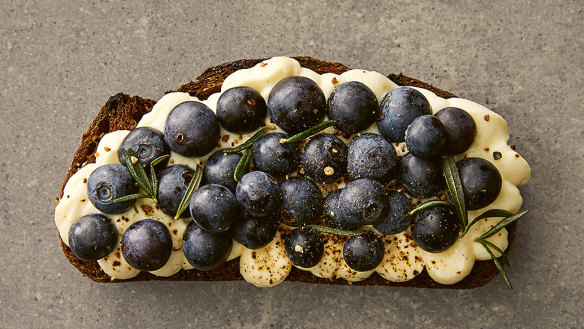
Whipped ricotta, blueberry, fried rosemary and black pepper
In a food processor, blend together some ricotta and a pinch of salt, then, with the blades spinning on high speed, drizzle in some olive oil and blitz until the ricotta is smooth and creamy, about two minutes. Spread or pipe this goodness onto your toasts, top with a scatter of blueberries, a sprinkle of crisp-fried rosemary, an extra slug of olive oil and quite a bit of freshly cracked black pepper.
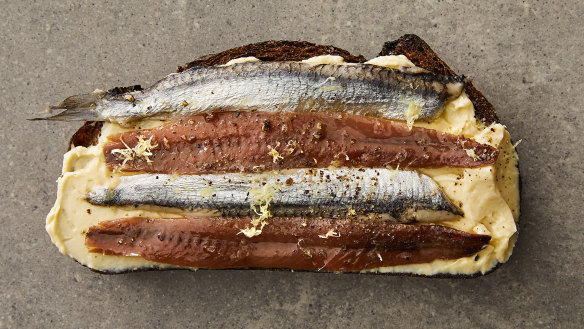
Anchovies on toast
Quite possibly the greatest toast of all time – a version of the Spanish tosta matrimonio. Take your toast, still warm from the grill, and spread it with a good layer of egg butter (see below). Have you heard the term “teeth butter”? It’s when you take a bite and your teeth leave a cast in the butter; that’s what I mean by a good layer: lots. On top, lay one salted anchovy and one boqueron, the white pickled anchovy, side by side in wedded harmony, then do it again. Season with a sprinkle of freshly cracked black pepper and a rasp of lemon zest and cut it into two fingers to serve.
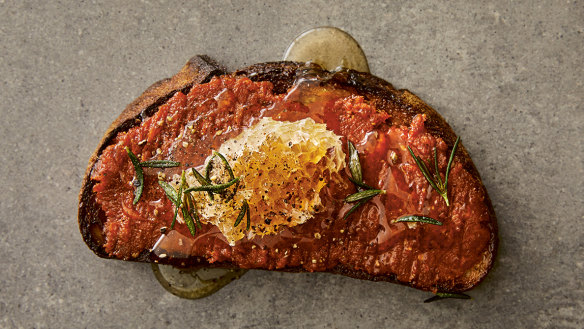
𝄒Nduja and honeycomb
Drizzle a little olive oil over the top of your toast, then spread it with a thick layer of 𝄒nduja (spicy, spreadable pork sausage from Italy) or sobrasada (cured sausage from Spain) that you’ve brought to room temperature. Spoon a teaspoon of fresh honeycomb on top of your spicy pork, right in the centre, letting the honey run where it pleases. Top with a few sprigs of crisp-fried rosemary leaves and a little turn of fresh black pepper.
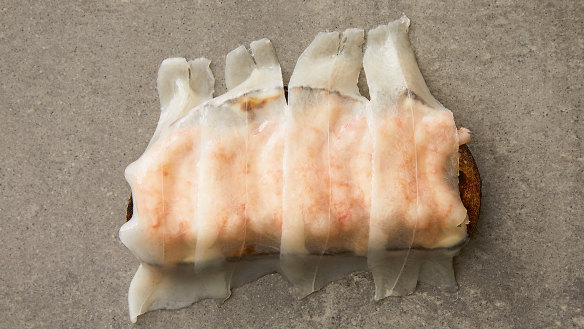
Prawn, harissa and lardo
Spread your toast with some bagna cauda butter (see below), add a little dab of fermented chilli (see below), or more than a dab if you’re feeling it. Line up three cooked school prawns (preferably still warm from being gently grilled over a fire, but poached works here too) per piece of toast. Cover them with a veil of thinly sliced lardo (Italian cured pork fat) – the heat radiating from the prawns and the toast should be enough to just warm the lardo, rendering it a little transparent and seasoning the other ingredients sufficiently.
Tomatoes
Toast is at its finest under a slice of tomato at the peak of ripeness, warm from the sun, with nothing else needed beyond some peppery olive oil, flaky sea salt and loads of freshly cracked black pepper.
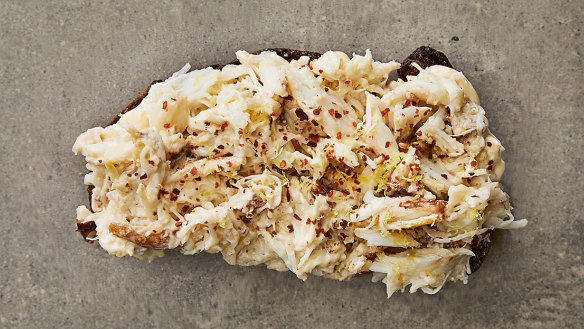
Crab toast
This is the perfect thing for any leftover salt-baked crabmeat (see below). Bring some egg butter (see below) to room temperature if you have some on hand, otherwise aioli is just as agreeable. Gently fold it into your crabmeat with a whisper of grated lemon zest, a suggestion of chilli flakes and some chives or parsley if you have some, then spread this thickly on warm toast.
Egg salad
Prepare one eight-minute boiled egg per toast. Peel the egg, then cut it in half. Take the yolk out and mash it in a bowl with a fork, then mix in a tablespoon of onion aioli (see below), stirring it thoroughly to a smooth, creamy consistency. Now add the white of the egg and rough it up with the fork, but don’t pulverise it – some texture is a plus. Fold in a little more of the aioli and mix it all together until you’re satisfied with the consistency. Season with salt and, for me, an aggressive amount of black pepper. How you go from here is up to you. I like hot sauce or chilli flakes, and am rather partial to a few soft herbs. Mustard is great, as is some very thinly sliced raw white onion. Or give it some capers and some chopped-up cornichons and turn it into a gribiche of sorts. You might even want to introduce some avocado, but I can’t in good conscience recommend it.
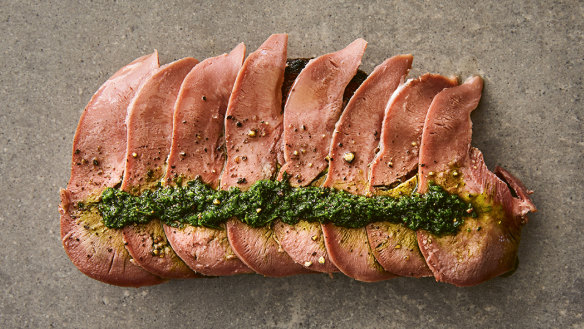
Grilled tongue and green sauce
Lamb’s tongue is a particular favourite for this one. Take a tongue that has been simmered gently to tenderness, then peeled and cooled. Cut it lengthways from the throat end to the tip into fairly thick slices – about four slices per tongue. Pan-fry the slices on their flat sides until they’re nicely coloured, then mount them on toast spread thickly with aioli and spoon some green sauce (see below) on top. Some salted capers that have been rinsed then deep-fried to a crisp are a possibly unnecessary, yet not entirely unwelcome, addition.
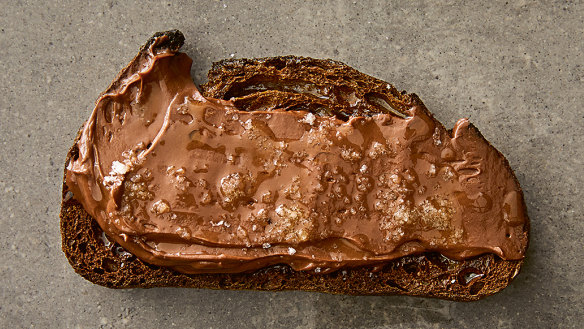
Chocolate, olive oil and sea salt
An inspired toast born from Catalan ingenuity, and just as relevant at breakfast as it is after dinner. Melt some excellent bittersweet dark chocolate over a double boiler (or give it a blast in the microwave) and spread it over your toast, then give it a light drizzle of a fruity extra-virgin olive oil and a reasonable sprinkling of flaky sea salt.
Peanut butter and sesame-seed sambal
Kind of like a satay peanut butter and jelly. Sounds weird but works exceedingly well. Spread a nice layer of butter on your toast, and just as the butter is melting, add a tablespoon of sesame-seed sambal (see below) and spread it, mixing it into the butter. Top with a layer of crunchy peanut butter – about twice as much as the sambal. Nice with a little sprinkle of flaky sea salt.
Grilled leeks and labne
Take half a leek (cooked as for the burnt leeks and sesame-seed sauce, see below) per piece of toast and rough it up a little with your knife. You just want to break it up a little but leave yourself with something to chew on. In a bowl, season the leek well with flaky sea salt, black pepper, some flakes of Aleppo pepper and a squeeze of lemon juice, then lubricate it with a slug of a nice extra virgin olive oil. (Some orange juice also works well here if it’s not too sweet.) Spread the toast with a strategically thick layer of well-seasoned labne, then pile on the leeks and some of their dressing, spreading it out to the edges.
Pear, black radish and parmesan
Season some butter with a healthy amount of freshly cracked black pepper. Spread this on your waiting toast. Top with a few thin slices of ripe, juicy pear. Follow this with an equal amount of thinly sliced radish, seasoned with salt. The black-skinned Spanish radish works best here, but all you really need is a crisp radish that has a bit of punch to it. Avoid daikon, though – I find it too juicy for this union. Top with a few vegetable-peeler shavings of parmigiano reggiano and a little spill of peppery olive oil.
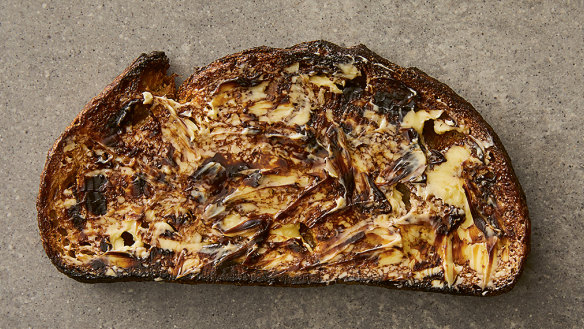
The correct amount of Vegemite
Just to set the record straight on this. To my mind, people who say they don’t like Vegemite, Australia’s popular yeast-based savoury spread, have usually been introduced to it in an aggressive manner, perhaps even as the victim of a practical joke, the bread buried under eye-watering amounts of the spread. It’s best to think of Vegemite as a seasoning for your bread and butter. You need warm toast, lots of butter, and just a scraping of the good stuff – no more than half a teaspoon per slice. And definitely, definitely no avocado.
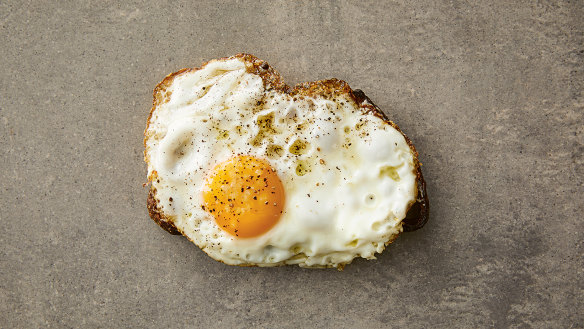
And...
- A fried egg with lots of black pepper
- Cinnamon and sugar
- Banana, tahini and honey
- Salted butter and golden syrup
- Cream cheese and overripe figs
- Salted butter and sliced radishes
- Fresh and fermented cucumbers, butter and hot mustard
- Roast potato and mascarpone
- Olive oil and za’atar
- Anchovies, butter and lemon zest
- Pickled mussels and aioli
- Ripe tomato, raw red onion, butter and salt
- Uni and lardo
- Grilled pineapple jam and lardo
- Broad bean hummus and lardo
- Lardo and more lardo
- Chicken-liver pâté and pickled onion
- Pork terrine
- Beef tartare (see below), parmesan and hot sauce
- Braised cavolo nero and egg butter (see below)
- Sardines, bagna cauda butter (see below) and pickled fennel
- Grilled pipis and laverbread
- Kefir cream (see below), dashi jelly (see below) and trout roe
- Crab, nasturtium and aioli
- Grilled bacon, Tabasco and curry-leaf brown butter (see below)
- Labne and grilled peaches

How to make...
Bagna cauda butter
A real bagna cauda is the “hot bath” of Piemontese tradition, served with crudites. This is not that. It’s more of an anchovy butter by another name.
INGREDIENTS
- 1 part anchovy fillets, packed in olive oil
- 2 parts drained confit garlic cloves (see below)
- 4 parts butter, diced and chilled
METHOD
- Put your chosen quantity of anchovy and confit garlic in a heavy-based saucepan. Be sure to bring a little of the oil from both into the mix. Gently heat to approximately 50C. With a stick blender, cream the mixture together until smooth and the two have become one.
- Take off the heat and, while still blending, emulsify the butter into the anchovy mix, slowly adding a little butter at a time, until it’s all incorporated. The result should be the texture of very thick cream – but obviously butter – and taste aggressively, but not unpleasantly, fishy and salty.
Confit garlic and its oil
INGREDIENTS
- 100g garlic cloves
- 200ml cottonseed oil (or any other neutral oil)
METHOD
- Heat oven to 130C fan-forced (150C conventional).
- Put the garlic cloves, oil and a pinch of flaky sea salt in a deep ovenproof pan or baking dish. You want the oil to cover the garlic completely.
- Bake until the cloves are very tender, and just starting to change colour to a darker shade, about 45 minutes.
- Cool briefly, then refrigerate. This keeps well covered in the fridge for a week or two, and is best kept in a cold section of the fridge.
Makes 300g
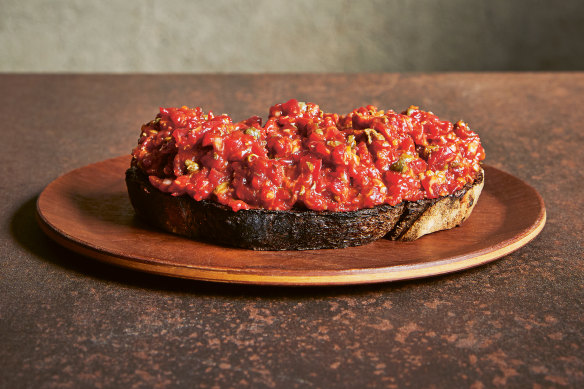
Beef tartare
Beef tartare makes a dignified start to a meal and doesn’t require much more than a trustworthy butcher and a very sharp knife. Use a lean cut of the best-quality meat you can find, ideally from a grass-fed beast, hopefully one that has lived well, soaking up sunlight and fresh air.
INGREDIENTS
- 200g beef rump, trimmed of all silver skin, fat and sinew
- 1 tbsp olive oil
- 1 tbsp fermented hot sauce, or your favourite hot sauce
- 1 tbsp finely diced shallots
- 1 tsp small salted capers, rinsed of salt
- 1 tsp fish sauce
- 1 egg yolk
METHOD
- Preparing the beef is the business of your sharpest knife. Cut the rump into 3mm dice and place in a chilled bowl set over another bowl filled with ice; you want to keep the meat as cold as possible.
- Coat the meat with the olive oil first, then mix in the hot sauce, beating a little vigorously with a fork for a minute to get the meat sticking to itself a bit, then add the shallot and capers, season with the fish sauce, a pinch of flaky sea salt and a healthy grind of black pepper. Gently fold in the egg yolk to add richness and shine.
- Pile the mixture onto a shallow bowl or plate and serve with your perfect potato chips, or some toast spread edge to edge with egg butter (see below) on the side. Or even serve it as a little snack piled on top of squares of crisp potatoes in place of the salted egg-yolk sauce.
Serves 4 as a snack or 2 as a starter
Curry-leaf brown butter
A preparation yielding both a fragrant butter that can be spread on a multitude of things as well as crisped leaves for topping curries or dhal.
Melt 100g unsalted butter in a saucepan over medium heat. When the butter starts to foam, add a large handful of fresh curry leaves and cook for 2 minutes or until the butter has browned and the curry leaves have darkened and are crisp. Strain the butter through a fine sieve, keeping both the flavoured brown butter and the crisp leaves.
Makes 100g
Dashi jelly
If you’re used to making stock in the Western way – by cooking bones for a very long time – then making dashi, the stock that is central to Japanese cooking, can be a revelation. The keys here are buying good kombu and not letting it boil – when kombu gets too hot it becomes bitter.
INGREDIENTS
- 30g kombu
- 15g dried shiitake mushrooms
- 50g bonito flakes (katsuobushi)
- 16g flaky sea salt
- 60ml (¼ cup) tamari
- gold gelatine, at 1.8 per cent weight of finished dashi (for example, for 100ml dashi use 1.8g gelatine)
METHOD
- Fill a pot with 1.9 litres water, add the kombu and mushrooms and leave at room temperature for 1 hour to soak.
- Place over low heat and slowly bring it to the point where small bubbles are forming on the base of the pot. You want the liquid to be at 60C; let it boil and the dashi will be spoilt.
- Remove the mushrooms and kombu (you can keep the kombu to use again for another purpose, like the braised kombu opposite) and bring the liquid up to 80C. Take it off the heat, then add the bonito flakes. When the flakes sink to the bottom of the pot, skim off any scum that has risen to the surface (this scum would give an unpleasant bitter astringency to the final product). Strain through a coffee filter. This is your dashi.
- Season the dashi with salt and tamari. It should taste deeply savoury but not salty, full of body, and have a pleasant, slightly fishy aroma.
- To make the jelly, weigh your dashi and weigh out 1.8 per cent of that weight in gold gelatine. Soften the gelatine in cold water for a few minutes; this allows it to disperse more evenly in the liquid when it’s heated. Heat the dashi to 60C, melt in the squeezed-out gelatine and whisk well to ensure it has dissolved completely.
- Pour the dashi jelly into a clean, wide container to a depth of 1cm, using more containers if you need. Leave to cool, then cover and refrigerate overnight to fully set.
- Dashi jelly will keep for up to a week in the fridge.
Makes close to 2 litres (8 cups)
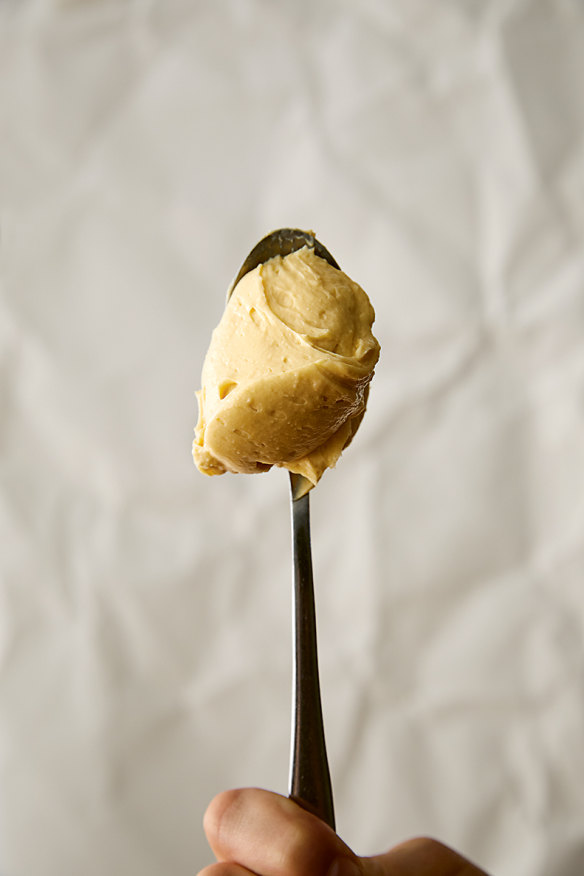
Egg butter
Salt, fat, acid, heat. This particular preparation has found many uses in my kitchen, and I am confident you will come upon many more on your own. I find it particularly apt in any matter involving toast.
INGREDIENTS
- 5 boiled eggs (the eggs boiled for 6 minutes, then plunged into iced water)
- 1-1½ tbsp Dijon mustard
- 1-1½ tbsp brown rice vinegar
- 400g almost-burnt butter, melted but not hot
METHOD
- Put the eggs, mustard, vinegar and a pinch of flaky sea salt in a blender and blend to a very smooth puree.
- With the motor running, slowly drizzle in the butter, as if you were making a thick and slightly more decadent version of mayonnaise. Season with vinegar and a little more salt if you feel it needs it.
- Store your egg butter in a sterilised jar in the fridge for up to a week.
Makes 500g
Fermented chilli
The heat of chilli peppers varies from batch to batch, so have a little nibble (courage!) before committing. If you want to tone it down, remove some of the seeds and the white membrane they’re attached to (the hottest part) from a portion of the chillies before you proceed. It might be an idea to wear gloves while you do this.
INGREDIENTS
- 550g long red chillies
- 50g flaky sea salt
- vegetable oil, for drizzling
METHOD
- Remove the green stems from the chillies, then weigh the chillies. Next, weigh out 10 per cent of the weight of the chillies in sea salt (50g salt for 500g de-stemmed chillies, for example).
- Blitz the chillies and the salt together roughly in a food processor, until there’s just a little bit of chunkiness left.
- Put the salted chilli into a sterilised jar, cover it with a light slick of neutral oil and leave it at room temperature for a week to ferment.
- Give it a stir every couple of days to keep the top layer moist, until you see signs of a slight fizz, then put it in the fridge to arrest the fermentation. It should keep for several months.
Makes 500g
Green sauce
More of a direction than a recipe, and very adaptable. The number, measure and combinations of ingredients in a salsa verde such as this are dictated by your personality, what you have on hand and the sauce’s intended target. The only rule is in the name: it should be green.
INGREDIENTS
Use very fresh, clean, dry herbs. My preference is to include:
- flat-leaf parsley (50g)
- watercress (25g)
- coriander (25g)
- chives (20g)
- anchovy fillets (3)
- lemon zest and juice (of 1 lemon)
- salted capers (5g), rinsed of excess salt
METHOD
- Choose your combination.
- Chop half the herbs very fine.
- Chop half the herbs less fine.
- Mash the anchovies to a paste and add them to the herbs.
- Anoint the mixture with a nice lively olive oil, enough to make it a sauce but not so much as to leave the herbs swimming.
- Add some lemon zest, Microplaned or finely chopped, depending on the occasion.
- Perhaps grind in some pepper.
- Squeeze in some lemon juice (strain out the seeds; biting into one can ruin your day).
- Once your chosen ingredients have met, cover the surface of the sauce tightly and let it sit at room temperature for half an hour to let everything mingle and find its place, then taste and adjust the seasoning as needed – it may need a pinch of salt.
Burnt leeks and sesame-seed sauce
Conveniently enough, the best thing to cook the inside of a leek in is the outside of a leek. Leeks also love fire – cook them till the outsides are really well blackened and starting to split. Erring on the side of more cooked is what we want here.
INGREDIENTS
- 4 large leeks, trimmed of just the darkest green tops (keep the tops) and washed of any dirt
- verjuice dressing, to taste
- 100g sesame-seed sauce (see below)
- toasted breadcrumbs
Leek ash
- dark-green tops of 4 large leeks (reserved from above)
METHOD
- For the leek ash, take the dark green tops of the trimmed leeks and completely burn and dry them out on a hot grill. Cool to let them crisp up, then blitz to a powder in a spice grinder.
- On a grill over a high open flame, burn the outside of the leeks, turning occasionally, until completely black all over. Continue until the leek starts to split open at the root end and release a little juice and leek steam. Immediately place leeks in a heatproof container just large enough to fit them all snugly. Cover tightly with foil and leave to cool to room temperature. In this time the leeks will finish cooking from the lingering heat, soften up, sweeten and take on a smoky flavour.
- On a serving plate, split and open out the outside burnt layers of the leeks to reveal the cooked hearts. Take the sweet leek hearts to a chopping board and slice into bite-sized rounds, then rearrange the slices in their original form atop the burnt layers. Dress with a tablespoon or two of verjuice dressing to add acidity, scatter with a little flaky sea salt, then blanket the leek hearts with the sesame-seed sauce. Sprinkle with breadcrumbs (for textural contrast) and give it all a light dusting of leek ash to emphasise the smoked flavour.
Serves 4
Sesame-seed sauce
Having half the sesame seeds raw and half toasted balances out the flavour. If they’re all raw, the flavour is flat and, to me, a little dusty, whereas toasting them all makes the sauce too rich. This makes a lot, but it’s tough to blend in smaller quantities, so the best result comes from making a large batch.
INGREDIENTS
- 250g (3⅓ cups) sesame seeds (half toasted to a light golden brown, half raw)
- 5g xanthan gum (from health-food shops)
- raw unpasteurised honey, to taste
METHOD
- Blitz sesame seeds with 250ml (1 cup) water in a blender on high speed for about 10 minutes, or until you have a smooth paste. Cover and refrigerate overnight to allow the seeds to fully hydrate.
- The next day, blend the paste with another 250ml (1 cup) water. With the motor running, add the xanthan, blending for 1-2 minutes to allow it to hydrate and thicken the sauce slightly. Add enough honey to neutralise the bitterness of the sesame seeds, and season with flaky sea salt to taste, blending again to combine.
- Pass through a fine sieve for a smooth, silky result. The extra sauce will keep refrigerated for 2-3 weeks. Try it with charred brassicas, or anywhere else you might use a tahini-style dressing.
Makes 500ml (2 cups)
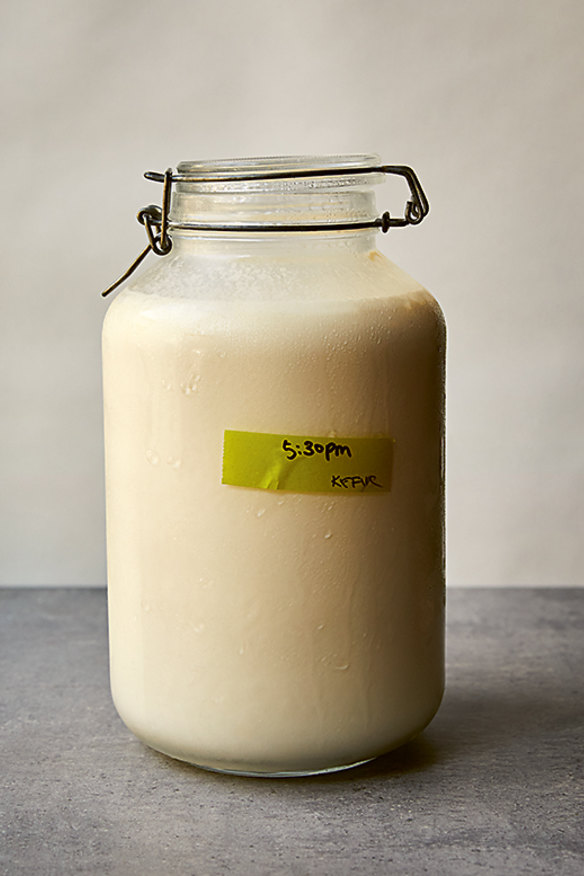
Kefir cream
INGREDIENTS
- 4 litres (16 cups) pure cream, raw (unpasteurised) if possible, the best quality you can find
- 250ml (1 cup) milk, inoculated with 2 tbsp of healthy and happy milk-kefir grains
METHOD
- Bring cream and milk kefir to room temperature in separate containers, simply leaving them out of the refrigerator (don’t apply any direct heat at all).
- Strain milk kefir into cream (reserving the grains), mix well, then decant into a sterilised glass jar. Cover with a breathable lid, like a piece of muslin secured with a rubber band (you can have a tight lid, which will increase the fizziness of the final product, but it also increases the chance of an explosion if you’re not attentive – treat this possibility seriously).
- Leave at room temperature (22C-24C is ideal), hidden from sunlight, for 24-48 hours. Give it a gentle mix once or twice if you remember, but all is not lost if you don’t.
- These timings are general, and the climate and the season will make a difference, with warmth speeding things up. Looking, touching and tasting are your best guide, ultimately: the kefir is ready when you give it a gentle nudge and it has set up, becoming more viscous. It should taste effervescent and yoghurty.
- The longer you let it go, the tarter and more acidic it will become. Once it’s thickened to your satisfaction, strain out the kefir grains and refrigerate it to bring the fermentation to a halt. It’s now ready to serve.
- To start the process again, put your kefir grains back into a clean, sterilised jar and feed with fresh milk. Keep your grains refrigerated, and give them a feed of fresh milk again at least every 2 weeks to keep them happy and thriving.
Makes 4 litres
Onion aioli
This sauce is slightly more subtle than the classic aioli: a little sweeter from the onion oil, and hot enough from the garlic, which enhances without overpowering.
INGREDIENTS
- 2 garlic cloves
- a few pinches of flaky sea salt
- 2 egg yolks
- 6g Dijon mustard
- 1 confit garlic clove (see above)
- 200ml oil from confit onion (see below)
- 1 tbsp brown rice vinegar
METHOD
- Make sure all your ingredients are comfortably at room temperature before you begin.
- Chop the raw garlic finely, then transfer it to a large mortar with a pinch of salt. Mash it with a pestle until it becomes a thick paste. Introduce the egg yolks, mustard and confit garlic clove and mix to a paste.
- Now add the oil, very slowly at first, a few drops at a time, mixing with the pestle evenly and always in the same direction, until an emulsion forms. Continue drizzling and mixing until all the oil is added. Once it is, and the sauce is stable, season it with the vinegar and some more salt to suit your taste. The result should be rich and creamy, with a little tingle from the vinegar.
- Store it, covered, in the fridge for up to a week. For best results, bring it back to room temperature before use.
Makes 250ml (1 cup)
Confit onion
INGREDIENTS
- 1kg brown onions
- 15g flaky sea salt
- 375ml (1½ cups) extra-virgin olive oil
- 15g light brown sugar
- 3 tsp brown rice vinegar
METHOD
- An hour before cooking, thinly slice the onions across the grain into fine rings (a mandolin makes short work of this) and massage them with the salt. This early step will help caramelisation later on.
- When your hour is up, heat a wide, heavy-based saucepan over medium heat. Add the olive oil to the onions, stir to coat thoroughly, then transfer to the hot pan. Slowly cook the onions, stirring occasionally with a wooden spoon, until softened and a deep brown colour – this will take roughly an hour. (If your attention wanders and you find your onions have stuck to the bottom of the pan and over-caramelised, but have not properly burnt, they can be rescued: turn off the heat and leave the pan alone for half an hour or so. The onions should then be more agreeable to being unstuck with a bit of a scrape with your wooden spoon, and the onion flavour only improved.)
- In the last few minutes, add the sugar and vinegar and stir until the sugar has dissolved and the onions are evenly coloured.
- Keep your confit onion refrigerated in a sealed container for up to 3 weeks.
Makes just over 250ml (1 cup), plus oil
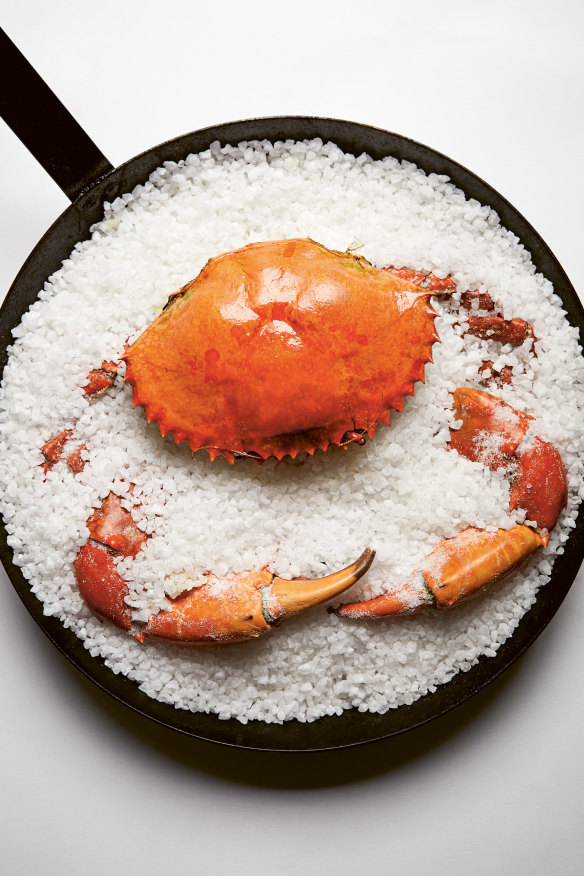
Salt-baked mud crab
This is my favourite way to cook and eat crab. By adding only salt and heat, we amplify the natural brininess and bring out the sweetness in the flesh.
INGREDIENTS
- 1kg live mud crab (pick one that’s frisky and heavy for its size)
- 1kg rock salt
- 4 soft-boiled eggs
- 1 tbsp mustard
- 125ml (½ cup) almost-burnt butter, warmed to 50C
- 2 tbsp brown rice vinegar
- fresh bread or steamed buns, to serve
- lemon wedges, to serve
METHOD
- Put the crab in the freezer for about an hour to put it to sleep and make it easier to dispatch.
- Once it has slipped into a deep slumber, remove from the cold. Turn the crab onto its back, and you will see a V-shaped tail tucked in. Pull this out and flip the crab over again. Put your thumbs in under the tail and liberate the shell by pushing upwards firmly while bracing the back legs with your middle and index fingers. (A little bit unsettling on the first try, but surprisingly easy to do; less easy if the crab isn’t as asleep as you first thought.) Take off the grey-looking “dead man’s fingers”, the eyes and the little hard bits at the mouth. Reserve the top shell.
- Scrape out all the coral and roe and pass it through a fine sieve into a bowl and refrigerate. This will be used to make a buttery dipping sauce that’s essential to the experience.
- Cut the crab into halves down the centre, then, with a rolling pin or other heavy, blunt object, gently crack the claws and the heavier, thicker parts of the arms, being careful not to shatter them or precious juice may be lost.
- Heat oven to 270C fan-forced (250C conventional). In a heavy-based ovenproof frying pan, make a bed with a third of the salt, sit the crab on top and replace the top shell, almost reforming it into its natural shape, but making sure that the cut sides of the crab are not quite touching in the middle. Cover with the remaining salt, avoiding the exposed flesh where possible. The trick here is to put more salt over the thinner parts of the crab and less over the big parts, like the claws, for a more even result.
- Roast the crab for about 15 minutes. (If you hear the hiss of steam coming from the salt, there’s a good chance it’s ready.) Remove from oven and allow to cool for 10 minutes in the salt, which will help set the flesh. Cool to room temperature before serving.
- While the crab is roasting, make the sauce. Put the eggs, mustard and sieved crab coral in a saucepan and heat to 50C while blending with a stick blender. With the blender still going, drizzle in the warmed butter in a thin, steady stream, emulsifying it as if you were making an aioli. (I usually do this in a Thermomix, so if you have one, use it to blend and heat it all to 50C.) Season with the vinegar. The sauce should be fatty and rich, sharp from the vinegar, with a backbone of funk from the crab innards.
- There is no need for salt in this sauce; you’ll get all the seasoning you need from the crab itself. Reassemble the crab on a large plate, spooning the sauce into the upturned carapace and giving it a good grind of black pepper.
- Roll up your sleeves: you can’t get the best out of this without using your hands. Take your crab out of the pan and brush off any stubborn rocks of salt still clinging to it.
- Take your time; dismantling the different parts of the crab will reward you with different pleasures. Savour the process, using the dipping sauce only every other mouthful. Eat it with fresh bread, or Chinese steamed buns, making little crab sandwiches as you go. (Beware the temptation to fill up on bread too early.) Make good use of fresh lemon juice. Lick your fingers. Life is good.
Serves 2
Sesame-seed sambal
As a young cook I would regularly make the two-hour trip to the Blue Mountains to eat at Vulcans, a little restaurant set in a retired bakery in the town of Blackheath. The menu, built around a hulking 19th-century wood-red Scotch oven, was small, but the cooking was thoughtful and generous. Textured, fragrant soups, duck-neck sausages, oyster blades of beef cooked slow and whole, the platonic ideal of roast potato. With an abundance of character and little pretence, this was where the spark for my own wood-red restaurant was ignited.
This recipe is a straight-up attempt at recreating the sambal that chef Phillip Searle made at Vulcans. I can’t claim to have captured that same magic, exactly, but I think the result is still quite delicious.
If you have the chance, cook this slowly in the dying heat of a wood-fired oven. This may seem like it makes a lot of sambal, but it’s worth the investment (it can take up to 12 hours to cook, after all). It also keeps for up to three months in the fridge, and makes a perfect gift.
INGREDIENTS
- 500g white onions, minced and drained in a sieve overnight
- 100g garlic cloves, minced
- 500g long red chilli, minced
- 500g sesame seeds
- 500ml (2 cups) vegetable oil, or enough to just cover the rest of the ingredients
- 50g caster sugar
- 400ml tamarind water
- flaky sea salt, in the vicinity of 60g, but let your tastebuds be your guide
METHOD
- Mix the onion, garlic, chilli and sesame seeds together in a bowl.
- In a wide, heavy-based saucepan over medium-high heat, bring enough vegetable oil to just cover the rest of the ingredients to 130C (use your judgment; if you need more after adding the next step, add a little more). Quickly but carefully introduce the onion, chilli, garlic and sesame mix to the hot oil in one go. It will object a little at first but then the temperature will drop and things will calm down. Bring the mixture slowly back to a gentle simmer, then turn the heat down as low as your situation will allow (a simmer mat is useful here) and cook it as slowly as you can for about 2 hours. Give it a stir with a wooden spoon every other time you walk past the pot.
- Left alone for too long, this mix will catch and burn. Try not to let that happen. But if it does get away from you, don’t scrape the bottom of the pan with your spoon or try to mix the burnt bits through the sauce. Once a sauce has stuck, it’ll have a taste for sticking and stick again every chance it gets. If it’s not too badly burnt, and you think the flavour is still OK, it can be rescued (if it’s really burnt, sadly, you’ll be best off starting over; yes it does taste burnt, and, yes, everyone will taste it). Change pots, or take out the sauce, clean the pot and resume, this time more attentively.
- Taste the sambal regularly as it cooks to track its progress; when there’s no taste of raw garlic left (after about 2 hours), add the sugar and continue to cook slowly until the sambal has darkened and is fragrant with chilli. Season with just enough tamarind so that you know it’s there but would have to be told what it is – it should be more subliminal than a feature (you may not need all of it). Salt rationally; this is the perfect example of a time when you can add but you can’t subtract. Made patiently, this sambal can take up to 12 hours to cook, so add seasoning conservatively, tasting with every addition.
- The finished product should taste sweet, nutty and hot, with just an underlying layer of tartness. Allow to cool completely then store, refrigerated, in clean glass jars.
Makes 2 litres (8 cups)
This is an edited extract from Ester by Mat Lindsay with Pat Nourse, Murdoch Books, RRP $55. Photography: Patricia Niven. Buy now
Related Article
Appears in these collections
The best recipes from Australia's leading chefs straight to your inbox.
Sign upFrom our partners
Original URL: https://www.watoday.com.au/goodfood/recipes/39-things-to-put-on-toast-that-aren-t-avocado-20230924-p5e76u.html
